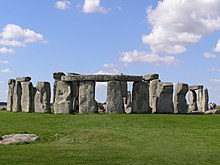
Back Stonehenge Afrikaans Stānhencg ANG ستونهنج Arabic ষ্ট'নহেঞ্জ Assamese Stonehenge AST Stounhenc Azerbaijani استون هنج AZB Стоунһендж Bashkir Stonehenge BAN Stonehenge BAR
 Stonehenge in July 2007 | |
| Location | Wiltshire, England |
|---|---|
| Region | Salisbury Plain |
| Coordinates | 51°10′44″N 1°49′34″W / 51.17889°N 1.82611°W |
| Type | Monument |
| Height | Each standing stone was around 13 ft (4.0 m) high |
| History | |
| Material | Sarsen, Bluestone |
| Founded | Bronze Age |
| Site notes | |
| Excavation dates | Multiple |
| Ownership | The Crown |
| Management | English Heritage |
| Website | www |
| Type | Cultural |
| Criteria | i, ii, iii |
| Designated | 1986 (10th session) |
| Part of | Stonehenge, Avebury and Associated Sites |
| Reference no. | 373 |
| Region | Europe and North America |
| Official name | Stonehenge, the Avenue, and three barrows adjacent to the Avenue forming part of a round barrow cemetery on Countess Farm[1] |
| Designated | 18 August 1882 |
| Reference no. | 1010140[1] |
 3D model (click to interact) | |
Stonehenge is a prehistoric megalithic structure on Salisbury Plain in Wiltshire, England, two miles (3 km) west of Amesbury. It consists of an outer ring of vertical sarsen standing stones, each around 13 feet (4.0 m) high, seven feet (2.1 m) wide, and weighing around 25 tons, topped by connecting horizontal lintel stones. Inside is a ring of smaller bluestones. Inside these are free-standing trilithons, two bulkier vertical sarsens joined by one lintel. The whole monument, now ruinous, is aligned towards the sunrise on the summer solstice and sunset on the winter solstice. The stones are set within earthworks in the middle of the densest complex of Neolithic and Bronze Age monuments in England, including several hundred tumuli (burial mounds).[2]
Archaeologists believe that Stonehenge was constructed in several phases from around 3100 BC to 1600 BC, with the circle of large sarsen stones placed between 2600 BC and 2400 BC. The surrounding circular earth bank and ditch, which constitute the earliest phase of the monument, have been dated to about 3100 BC. Radiocarbon dating suggests that the bluestones were given their current positions between 2400 and 2200 BC,[3] although they may have been at the site as early as 3000 BC.[4][5][6]
One of the most famous landmarks in the United Kingdom, Stonehenge is regarded as a British cultural icon.[7] It has been a legally protected scheduled monument since 1882,[1] when legislation to protect historic monuments was first successfully introduced in Britain. The site and its surroundings were added to UNESCO's list of World Heritage Sites in 1986. Stonehenge is owned by the Crown and managed by English Heritage; the surrounding land is owned by the National Trust.[8][9]
Stonehenge could have been a burial ground from its earliest beginnings.[10] Deposits containing human bone date from as early as 3000 BC, when the ditch and bank were first dug, and continued for at least another 500 years.[11]
- ^ a b c Historic England. "Stonehenge, the Avenue, and three barrows adjacent to the Avenue forming part of a round barrow cemetery on Countess Farm (1010140)". National Heritage List for England. Retrieved 13 December 2023.
- ^ Young, Christopher; Chadburn, Amanda; Bedu, Isabelle (January 2009). "Stonehenge World Heritage Site Management Plan 2009" (PDF). UNESCO: 20–22.
- ^ Morgan, James (21 September 2008). "Dig pinpoints Stonehenge origins". BBC. Archived from the original on 22 September 2008. Retrieved 22 September 2008.
- ^ Cite error: The named reference
Guardianwas invoked but never defined (see the help page). - ^ Cite error: The named reference
Independentwas invoked but never defined (see the help page). - ^ Cite error: The named reference
BBC Newswas invoked but never defined (see the help page). - ^ Scott, Julie; Selwyn, Tom (2010). Thinking Through Tourism. Berg. p. 191.
- ^ "History of Stonehenge". English Heritage. Archived from the original on 2 June 2016. Retrieved 7 June 2016.
The monument remained in private ownership until 1918 when Cecil Chubb, a local man who had purchased Stonehenge from the Antrobus family at an auction three years previously, gave it to the nation. Thereafter, the duty to conserve the monument fell to the state, today a role performed on its behalf by English Heritage.
- ^ "Ancient ceremonial landscape of great archaeological and wildlife interest". Stonehenge Landscape. National Trust. Archived from the original on 18 June 2008. Retrieved 17 December 2007.
- ^ Pitts, Mike (8 August 2008). "Stonehenge: one of our largest excavations draws to a close". British Archaeology (102): 13. ISSN 1357-4442.
- ^ Schmid, Randolph E. (29 May 2008). "Study: Stonehenge was a burial site for centuries". Associated Press. Archived from the original on 4 September 2015. Retrieved 2 August 2015.
© MMXXIII Rich X Search. We shall prevail. All rights reserved. Rich X Search
